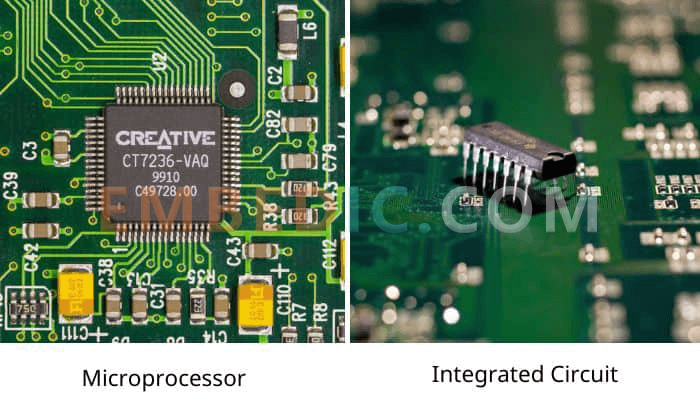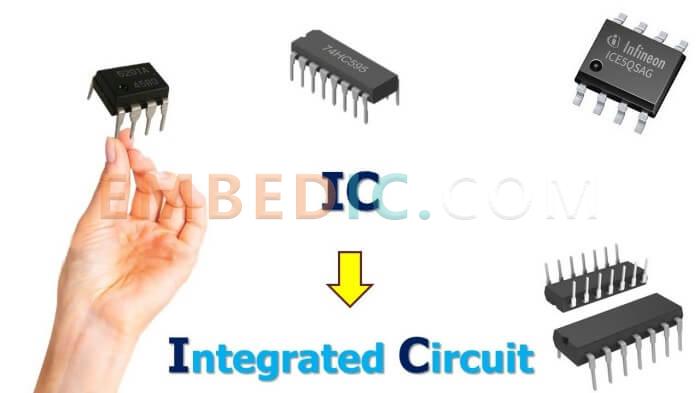Have you wondered how is a microprocessor different from an integrated circuit? The introduction of integrated circuit chips has revolutionized the way embedded systems operate today. By integrating transistor circuits onto a single chip, electronics developers can create advanced computing devices such as laptops and cell phones.

When discussing how embedded systems work, we often hear about integrated circuits and microprocessors. So what exactly are these components, how are they different, and how do they relate to embedded systems? In this article, we'll provide some background on their relationship and how they modernize the embedded systems industry.
A microprocessor is a central processing unit consisting of one or a few large-scale integrated circuits. It has the advantages of small size, light weight and easy modularity compared to conventional central processors. It is composed of a register stack, operators, timing control circuits, and data and address buses.
1. Register heap: It is an array of multiple registers in the CPU, usually implemented by fast static random read/write memory (SRAM).
2. Operator: The program counter is used to store the address of the unit where the next instruction is located.
3. Timing control circuit: Timing circuit, which is a circuit made up of the most basic logic gate circuit plus a feedback logic loop (output to input) or a combination of devices, is most essentially different from the combination circuit in that the timing circuit has a memory function.
4. Data and address bus: A bus is used to help connect two or more computer components. Three types of buses exist inside a computer, address bus, data bus and control bus. Address bus: This determines the memory location where the processor will read data from or write data to memory. Data bus: It contains the contents of the data that has been read from or will be written to a memory location. Control bus: It manages the flow of information between components, indicates whether the operation is a read or a write, and ensures that the operation occurs at the correct time.
Microprocessors can be broadly classified into three categories based on their application areas: general-purpose high-performance microprocessors, embedded microprocessors and digital signal processors, and microcontrollers.
16-bit BIT microprocessors
32-bit BIT microprocessors
64-bit microprocessors
You may like: [2022] The Complete Guide about MCU VS MPU and How to Choose
Integrated Circuit (IC) is the use of a specific manufacturing process, transistors, capacitors, resistors and inductors and other components and wiring interconnections, made on a number of semiconductor wafers or dielectric substrates, and then packaged in a shell, into a circuit function of the miniature electronic devices.
Integrated circuits, also called microcircuits, microchips are a way to miniaturize circuits (mainly semiconductor devices, but also passive components, etc.) in electronics, and are usually manufactured on the surface of semiconductor wafers.

Classified by function and structure, integrated circuits are mainly divided into digital integrated circuits and analog integrated circuits.
1. Transistors are made directly on single crystal silicon;
2. The components are integrated together in a highly dense manner, and the wires are getting thinner and thinner, currently down to the nanometer level
3. The external connection is led to the pin.
Further Reading: How is a Microprocessor Different From an Integrated Circuit (FAQs)
From the denifition of microprocessor and intergrated circuit above, we all know that,
1. A microprocessor is an integrated circuit. Not all integrated circuits are microprocessors.
2. Microprocessors are integrated circuits in terms of the composition of digital integrated circuits.
Integrated circuits paved the way for the advanced embedded systems we know and use today. Semiconductor chips used in devices such as smartphones, tablets or laptops are integrated circuits that provide the electronic circuitry needed for the system to perform its intended function.
Microprocessors are the basic integrated circuits that embedded systems engineers often use in embedded designs. The microprocessor is used to control the CPU functions of the embedded system, which performs tasks such as retrieving and decoding instructions from main memory and using these instructions to perform arithmetic and logical operations on other memory or I/O devices.
Like microprocessors, integrated circuits require communication protocols to "communicate" and exchange data between various components in the system and even other ICs. Microprocessors typically use protocols including I2C, SPI, or USB to perform data exchange. With so many interconnected components, including microprocessors/microcontrollers, memory devices, and I/O peripherals, developing and designing embedded systems can be a challenge. It is important to ensure that each of these components are operating together to create a properly functioning system.
To determine if each component is working as expected, host adapters and protocol analyzers are useful tools that allow engineers to test and debug the system to verify its performance. By using these tools, users can easily emulate a master or slave device, quickly program memory, and monitor the bus for communication errors.
Manufacturer: Texas Instruments
IC DSP FIX/FLOAT POINT 841FCBGA
Product Categories: DSP
Lifecycle:
RoHS:
Manufacturer: Texas Instruments
IC DSP/ARM PROCESSOR 1031FCBGA
Product Categories: DSP
Lifecycle:
RoHS:
Manufacturer: Analog Devices
IC CCD SIGNAL PROCESSOR 88LFCSP
Product Categories: DSP
Lifecycle:
RoHS:
Manufacturer: Texas Instruments
CI DSP FIXED-POINT 164CFP
Product Categories: DSP
Lifecycle:
RoHS:
Looking forward to your comment
Comment